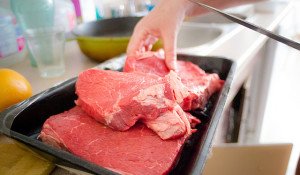Today is World Health Day and this year’s focus is on the issue of food safety. Did you know that one in six Americans could get sick from food poisoning this year alone? According to FoodSafety.gov, food poisoning not only sends more than 100,000 Americans to the hospital each year, but it can also have long-term health consequences.
On this day where we bring awareness to this local, national and global issue, we wanted to share some tips from FoodSafety.gov for how you can make sure the food you prepare is as safe as possible.
- Wash your hands: Washing your hands for 20 seconds with soap and running water can stop the spread of illness-causing bacteria.
- Wash surfaces and utensils: Bacteria can be spread throughout the kitchen and get onto cutting boards, utensils, and counter tops. Be sure to wash all surfaces and utensils after each use.
- Wash fruits and veggies, but not meat, poultry, or eggs: Even if you plan to peel fruits and veggies, it’s important to wash them first because bacteria can spread from the outside to the inside as you cut or peel them. No need to wash meat, poultry or eggs–washing raw meat & poultry can actually help bacteria spread and commercial eggs are washed before sale.
- Use separate items for produce, meat, poultry, seafood & eggs: Use one cutting board for fresh produce and one for raw meat and use separate plates for cooked and raw foods.
- Separate food at the grocery: Separate raw meat, poultry, seafood and eggs from other foods in your shopping cart and at the checkout ask that raw meat, poultry and seafood be placed in plastic bags to keep their juices from dripping on other foods.
- Separate food in the fridge: Bacteria can spread inside your fridge if the juices of raw meats drip onto your ready-to-eat foods. Keep raw meat, poultry and seafood in sealed containers (if you’re not planning to use within a few days, put in freezer) and keep eggs in their original carton stored in the main compartment of the fridge.
- Use a food thermometer: Cooked food is safe only after it’s been heated to a high enough temperature to kill harmful bacteria—color and texture alone won’t tell you whether food is done. Click here for a chart of safe minimum cooking temperatures.
- Keep food hot after cooking: The possibility of bacterial growth actually increases as food cools so keep your food above the safe temperature of 140 degrees by using a heat source like a warming tray or slow cooker.
- Microwave food thoroughly: To make sure harmful bacteria have been killed in your foods, microwave them to 165 degrees or higher.
- Refrigerate perishable foods within two hours: Cold temperatures slow the growth of illness causing bacteria. Chill food promptly and properly.
- Freeze: You can freeze almost any food, but remember that freezing does not destroy harmful bacteria—it keeps food safe until you can cook it. Your freezer should be at 0 degrees or below.
- Never thaw food on the counter: Since bacteria can multiply rapidly at room temperature, thawing or marinating foods on the counter is one of the riskiest things you can do. Instead, thaw/marinate in your refrigerator, in cold water or in the microwave.
- Know when to throw food out: While looking and smelling may give you a good idea on what is good and not good in your fridge or freezer, you really need to know the safe storage times for your food. Checkout this great chart for proper storage times.
Talk to us: What is the one thing you do daily to keep your food safe?
image courtesy of flickr CC/Kurt Bauschardt

